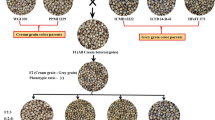Abstract
Grain color of wheat is one of the most important economic traits, affecting both flour quality and grain dormancy. As grain color reflects the phenotype of the seed coat, which is a maternal tissue, genotyping of this trait in segregating F2 plants requires an F3 progeny test. Consequently, the development of co-dominant molecular markers for grain color enables genotyping on a single grain basis and would expedite wheat breeding. R-1 genes control grain color and have been identified as MYB-type transcription factors, denoted as Tamyb10, which reside on the 3A, 3B, and 3D chromosomes, respectively. In an earlier study we developed co-dominant markers for R-A1 and R-B1 on chromosomes 3A and 3B, but could only develop one dominant marker for R-D1 because the mutant allele deleted the entire Tamyb10-D1 fragment with an unknown deletion size. DNA of individuals of the F2 population derived from crossing the white-grained line, 1–117, and the red-grained line, OW104, was isolated and used for real-time PCR. Relative amplification ratios of Tamyb10-D1 to Tamyb10-B1 in each of 96 individuals showed a bimodal distribution without overlapping, which allowed unequivocal classification of the F2 plants into a 1.0 (dominant homozygous) or a 0.5 (heterozygous) class, in accordance with a 1:2 expected ratio. Genotypes with the R-D1 grain color (4 plants per each class) were tested by an F3 progeny test. The results perfectly coincided with the genotypes deduced by the real-time PCR diagnosis. Consequently, the hemizygous status at the Tamyb10-D1 locus controlling grain color in wheat can now be diagnosed with the real-time PCR.



Similar content being viewed by others
References
Bagge M, Xia X, Lubberstedt T (2007) Functional markers in wheat. Curr Opin Plant Biol 10:211–216
Cockram J, White J, Zuluaga DL, Smith D, Comadran J, Macaulay M, Luo Z, Kearsey MJ, Werner P, Harrap D, Tapsell C, Liu H, Hedley PE, Stein N, Schulte D, Steuernagel B, Marshall DF, Thomas WT, Ramsay L, Mackay I, Balding DJ, Waugh R, O’Sullivan DM (2010) Genome-wide association mapping to candidate polymorphism resolution in the unsequenced barley genome. Proc Natl Acad Sci USA 107:21611–21616
Druka A, Kudrna D, Rostoks N, Brueggeman R, von Wettstein D, Kleinhofs A (2003) Chalcone isomerase gene from rice (Oryza sativa) and barley (Hordeum vulgare): physical, genetic and mutation mapping. Gene 302:171–178
Flintham JE (2000) Different genetic components control coat-imposed and embryo-imposed dormancy in wheat. Seed Sci Res 10:43–50
Heyne EG, Livers RW (1953) Monosomic analysis of leaf rust reaction, awnedness, winter injury and seed color in Pawnee wheat. Agron J 45:54–58
Himi E, Mares DJ, Yanagisawa A, Noda K (2002) Effect of grain colour gene (R) on grain dormancy and sensitivity of the embryo to abscisic acid (ABA) in wheat. J Exp Biol 53:1569–1574
Himi E, Maekawa M, Miura H, Noda K (2011) Development of PCR markers for Tamyb10 related to R-1, red grain color gene in wheat. Theor Appl Genet 122:1561–1576
Himi E, Yamashita Y, Haruyama N, Yanagisawa T, Maekawa M, Taketa S (2012) Ant28 gene for proanthocyanidin synthesis encoding the R2R3 MYB domain protein (Hvmyb10) highly affects grain dormancy in barley. Euphytica 188:141–151
Hirayama T, Kieber JJ, Hirayama N, Kogan M, Guzman P, Nourizadeh S, Alonso JM, Dailey WP, Dancis A, Ecker JR (1999) RESPONSIVE-TO-ANTAGONIST1, a Menkes/Wilson disease-related copper transporter, is required for ethylene signaling in Arabidopsis. Cell 97:383–393
Jende-Strid B (1994) Co-ordinator’s report: anthocyanin genes. Barley Genet Newsl 24:162–165
Jende-Strid B (1998) Proanthocyanidin-free 30, ant30. Barley Genet Newsl 29:99
Kaneko S, Komae K, Nagamine T, Yamada T (1994) Development of an extraction procedure for wheat red coat pigments and determination of varietal differences for this trait. Breed Sci 44:263–266
Kristiansen K, Rohde W (1991) Structure of the Hordeum vulgare gene encoding dihydroflavonol-4-reductase and molecular analysis of ant18 mutants blocked in flavonoid synthesis. Mol Gen Genet 230:49–59
Liu Y, He Z, Appels R, Xia X (2012) Functional markers in wheat: current status and future prospects. Theor Appl Genet 125:1–10
Mares D, Mrva K, Cheong J, Williams K, Watson B, Storlie E, Sutherland M, Zou Y (2005) A QTL located on chromosome 4A associated with dormancy in white- and red-grained wheats of diverse origin. Theor Appl Genet 111:1357–1364
Matus-Cadiz MA, Daskalchuk TE, Verma B, Puttick D, Chibbar RN, Gray GR, Perron CE, Tyler RT, Hucl P (2008) Phenolic compounds contribute to dark bran pigmentation in hard white wheat. J Agric Food Chem 56:1644–1653
McCallum JA, Walker JRL (1990) Proanthocyanidins in wheat bran. Cereal Chem 67:282–285
McIntosh RA, Yamazaki Y, Dubcovsky J, Rogers J, Morris C, Somers DJ, Appels R, Devos KM (2010) Catalogue of Gene Symbols for Wheat National BioResource Project. Committee for the National BioResource Project (NBRP)/KOMUGI, Tokyo. www.shigen.nig.ac.jp/wheat/komugi/genes/symbolClassList.jsp
Miura H, Sato N, Kato K, Amano Y (2002) Detection of chromosomes carrying genes for seed dormancy of wheat using the backcross reciprocal monosomic method. Plant Breed 121:394–399
Murray MG, Thompson WF (1980) Rapid isolation of high molecular weight plant DNA. Nucleic Acids Res 8:4321–4325
Nesi N, Jond C, Debeaujon I, Caboche M, Lepiniec L (2001) The Arabidopsis TT2 gene encodes an R2R3 MYB domain protein that acts as a key determinant for proanthocyanidin accumulation in developing seed. Plant Cell 13:2099–2114
Warner RL, Kudrna DA, Spaeth SC, Jones SS (2000) Dormancy in white-grain mutants of Chinese Spring wheat (Triticum aestivum L.). Seed Sci Res 10:51–60
Zhang L, Wang B, Pan L, Peng J (2013) Recycling isolation of plant DNA, a novel method. J Genet Genomics 40:45–54
Acknowledgments
The authors thank Dr. Shun-Ichi Osanai for the gift of the OW104 grain. We acknowledge Drs. Takashi Hirayama and Izumi C. Mori for their advice in the development of the DNA isolation method. This work was financed by the Wesco Scientific Promotion Foundation.
Author information
Authors and Affiliations
Corresponding author
Electronic supplementary material
Below is the link to the electronic supplementary material.
Rights and permissions
About this article
Cite this article
Himi, E., Maekawa, M., Matsuura, T. et al. Real-time PCR-mediated diagnosis of hemizygosity at the Tamyb10-D1 locus controlling grain color in wheat. Mol Breeding 35, 90 (2015). https://doi.org/10.1007/s11032-015-0251-3
Received:
Accepted:
Published:
DOI: https://doi.org/10.1007/s11032-015-0251-3




